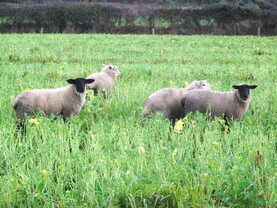Many of the factors which predispose to rumen fluke are similar to the factors which predispose to liver fluke. However, they must be treated as two different diseases. Cause
Many of the factors which predispose to rumen fluke are similar to the factors which predispose to liver fluke. However, they must be treated as two different diseases.
Cause
The life cycle of rumen fluke is similar to liver fluke in that eggs are laid by the adult fluke, which hatch on grass under favourable weather conditions. This intermediate stage enters the intermediate host, the water snail (a different species to the mud snail used by liver fluke). The water snail is a necessary requirement in the life cycle and explains why fluke infestations are high in wet years, and more commonly associated with poorly drained land. It is particularly associated with pastures which flood.
This intermediate stage of rumen fluke multiplies rapidly within the snail before leaving to colonise the pasture as infectious cysts that are taken in by grazing animals. The length of time that these cysts survive on pasture is dependent on both moisture and temperature. They can be killed within two days when exposed to direct sunlight in high or low temperatures. The cysts hatch in the upper part of the bowel and the young flukes that emerge feed on the lining of the intestine for about six weeks.
After this they move up into the forestomachs where they remain as adults. Cattle can develop immune resistance after exposure to the parasite. This immunity may protect the animal against the immature rumen fluke that cause the most significant clinical problems.
Symptoms
The most obvious sign of infestation is diarrhoea, accompanied by variable levels of anorexia and significant thirst with weanling cattle appearing to be the most susceptible. The most significant signs are caused by the young fluke in the upper intestine which can, when numerous, cause ulcers, damage to the lining of the bowel and haemorrhage. As a result, affected animals can develop anaemia (pale membranes) and a drop in blood protein leading to bottle jaw (where oedema fluid collects underneath the jaw). Poor thrive is a common feature of the disease. Mortality in acute cases can be significant.
If disease does not become evident during infestation by young fluke, the adults attach to the rumen and reticulum (forestomachs) and, depending on numbers, animals may not show any signs of the disease or may suffer ill-thrift. Affected animals demonstrate anaemia and weakness, with death in severe cases.
Clinical signs may be seen at any time of the year, but are most commonly reported in winter.
Treatment
The first step in any suspect case is to confirm the diagnosis. This can be done either by post-mortem examination of dead animals or confirming the presence of eggs in faeces. However, the latter only indicates that adult fluke eggs are present but are of limited value in the diagnosis of acute disease caused by immature rumen fluke in the upper intestine.
Medication for rumen fluke should only be carried out on affected farms or farms with a recent history of clinical disease. For rumen fluke, two treatments spaced three days apart gives best control of immatures and adults. However, a single treatment is suspected to be approximately 80% effective. A repeat treatment may be necessary approximately three months later if clinical signs and laboratory findings suggest treatment is required.
Late spring/pre-turnout treatment is aimed at removing remaining fluke that have over-wintered as adults within the animal and, as a result, stopping pasture contamination with fluke eggs contained in faeces.
Prevention and control
Adult rumen fluke can readily be visualised in the slaughter plant once the rumen is opened.
Another method to reduce the incidences of rumen fluke is to control the intermediate host, the water snail. It will inhabit pasture that was recently flooded. Drainage of areas prone to flooding or severe poaching provides the best long-term control. It is highly advised to fence off fluke habitats, particularly ditches, ponds, rushes and areas that are wet or muddy and slightly acidic – hotspots for snails carrying the disease. As a short-term control option, select drier paddocks for autumn grazing. If swampy areas are drained or converted into deeper, quickly moving water, snails and associated fluke risk will be greatly reduced.





SHARING OPTIONS: